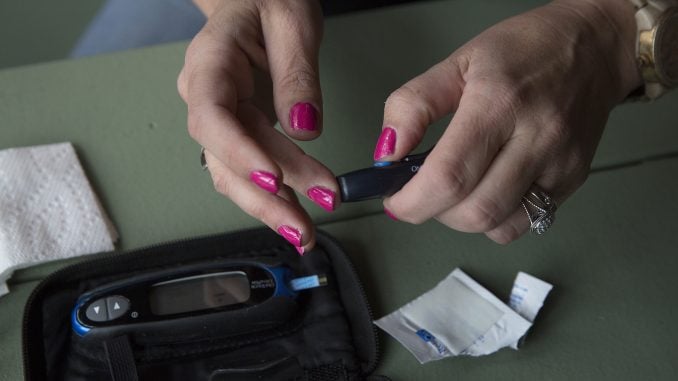
GREENVILLE — Going for two hamburgers instead of one; cutting back on physical activity to watch television; having a soda three times a day; all of these sugars and lack of exercise add up. And they can add up to diabetes.
It is the seventh leading cause of death in North Carolina, and approximately 827,000 adults report having been diagnosed with diabetes by their healthcare provider.
What is diabetes? What are the signs and symptoms? What do you need to know about it?
There are two types of diabetes Type 1 and Type 2. Type 1 is found in children and young adults. Type 1 is a chronic condition where the pancreas produces little or no insulin. Type 2, found in adults and usually diagnosed between the ages of 40 and 60, is a chronic condition that affects the way the body processes glucose (blood sugar). Insulin is a hormone produced by the pancreas and is important to the body because its function is to allow other cells to transform glucose into energy throughout your body.
“Indeed there is an epidemic of diabetes in North Carolina. The CDC in Atlanta mapped out a list of counties in the Southeastern United States which included Eastern N.C. as an area of the diabetes belt,” said Dr. Doyle “Skip” Cummings, Berbecker Distinguished Professor of Rural Medicine, a full professor in Family Medicine & Public Health and an Adjunct Professor of Health Education and Promotion at East Carolina University.
“There is a high incident of diabetes among people of color African-Americans, Latinos, Native Americans. The prevalence of diabetes in these three subgroups is 1.5 times higher than the white population,” he added.
Symptoms include the frequency of urination, remaining thirsty, hungry or fatigued, blurry vision, having cuts or bruises that are slow to heal, weight loss with Type 1, and tingling, numbness, or pain in your hands or feet with Type 2.
A Healthy Diet and Exercise
You can lower the risk of diabetes through healthy eating, avoiding smoking, and managing your weight and levels of glucose and blood pressure.
“Diabetes is a day to day struggle, battle, and effort, making it important to take best care possible of yourself. You have to make hard choices on diet and physical activity,” said Cummings.
Cummings suggests if you find yourself overweight or obese, try to limit further weight gain by regulating portion sizes, gaining control of your diet, choosing lean meats, eating fewer carbohydrates, including more vegetables in your food intake and being sensible about choosing fruits as some have excessive sugar.
“We suggest using your plate as a diagram divided into thirds for protein, fruits and veggies, and some fiber or grains. You can get a good sized portion in a portion, and still avoid overeating,” said Erica Hall, associate director for Community Health Strategies of the American Diabetes Association of the Carolinas.
Those healthy meals shouldn’t include sugary desserts or beverages like sweet tea, soda, and Kool-Aid.
“Sweetened drinks lead to calorie consumption. Drink water as much as possible. Limit sodas to diet drinks and cut out one to two sodas a day. Stay away from cookies and doughnuts. You can make small progress with physical activity as well. The goal is to turn your weight around and stabilize it,” said Cummings.
Physical activity makes a big difference in preventing diabetes and living with diabetes.
“The growth of obesity in the population is a concern as it’s the biggest single risk factor for diabetes. While family history, genetics, and biology play a factor as well, obesity is still a concern,” said Cummings.
“Park your car father from the grocery store entrance and walk. Use stairs rather than the elevator. Take a walk through the park. There are little things you can begin doing each day to get your moving,” said Hall.
Work with your Physician
Conversations with your physician are extremely important and can be key to helping you with diabetes.
“Many diabetes patients are cared for by their primary care provider. There are very few specialists in diabetes, known as endocrinologists, east of I-95. Eighty-five percent or higher of patients with diabetes are cared for by primary care providers,” said Cummings.
Your physician can help pair you with a nutritionist or behavioral health coach in the community to help you target all the areas important in living with diabetes. In addition, medications for diabetes can be expensive and cause weight gain or loss; so your physician can help find the right medicine for you.
The most common drug given for Type 2 diabetes is Metformin. It works by improving the sensibility of your body tissues to insulin so that your body uses insulin for effectively.
“Metformin is an extremely valuable drug for lots of reasons. It has even been tested in international studies and has demonstrated that is lowers body insulin resistance and prevents surges in carbohydrates breakdowns in muscles,” said Cummings. “It also has proven to lower the risk of cardiovascular issues in patients over a long period.”
Other medications fall into the classes of Sulfonylureas, Meglitinides, Thiazolidinediones, DPP-4 inhibitors, GLP-1 receptor agonists, SGLT2 inhibitors, and insulin therapy.
“All of these medications are valuable for different reasons. Some can lower cardiovascular risks and stroke outcomes, while others can assist with weight loss and stability,” said Cummings. “Working with your primary care provider can help find the one that’s best for you.”
What can you do?
Be aware of diabetes. Research. Ask Questions. Choose a healthier lifestyle.
“It is a fixable epidemic if more people are aware of the ways to prevent it, and then we will be in a better place in 2020,” said Hall. “One in 11 people are impacted by diabetes. The American Diabetes Association offers online information and numerous resources for living with and preventing diabetes. Give us a call. We are a small staff, but we can help you make a huge impact.”
Take time for yourself.
“We always tell our patients you have to allow yourself permission to take care of yourself,” said Cummings. “Make substantial changes in your lifestyle, and you will see a greater impact. Once you have diabetes, it will be a challenge you’ll work with for the rest of your life.”




